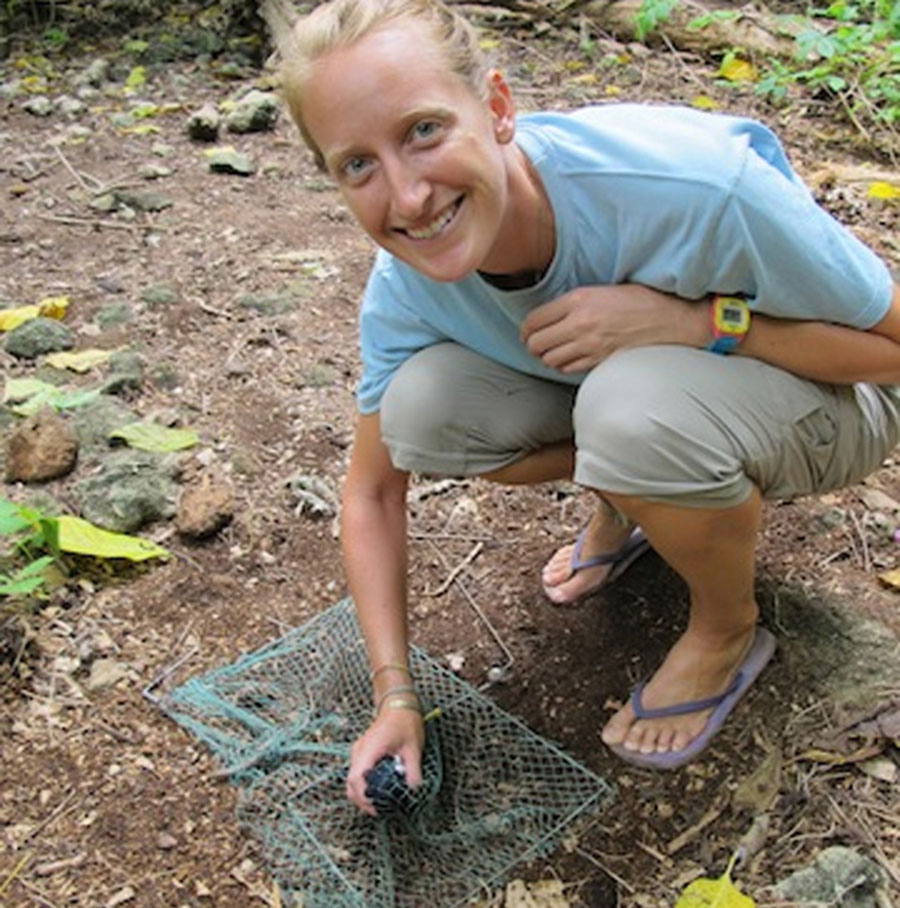
“Just another day in the office”, I think to myself as I sit crouched under some low ferns, brushing termites and dirt from my hands, whistling a simple bird call, slapping mosquitoes, and sipping from my water bottle to beat the heat. I gently grip the end of a long, thin, “transparent” piece of fishing line in my fingers while I peak through a slight gap in the dense fern cover at my partner who is similarly positioned about 10 meters away. His hand is all that is visible to me while I sit hidden from view of a small spring trap. When his hand gives the signal, I pull with all my might and hope that the little piece of wood propping open the trap comes out swiftly and triggers the spring. I can’t help but think this all feels vaguely reminiscent of an old trick my grandfather used to play on us kiddies at family gatherings during the summer.
Invariably, after the food was consumed, the marshmallows roasted, the ice cream melted, and the babies tucked in bed, he would pick the newcomer to the group—an unsuspecting friend or neighbor—and send them off on an epic “Snipe Hunt”. He would tell stories of a great bird living in the bush just at the edge of the yard, promising fame and fortune to whoever managed to trap the Snipe. He explained that with some perseverance and good luck, the Snipe could be captured by hiding in the bush with a burlap sack and rustling around imitating a bird call. Of course, those of us initiated to the prank already knew that this mythical Snipe was nowhere to be found, but we played along; building up the excitement and egging on the new member, only to laugh as he or she bumbled around the bush trying to catch the Snipe. I did not expect, as I giggled at the young neighbor boy from next door, that 20 years later I would be doing something all too similar for work. Only this time I am actually waiting for a bird, and a very important one at that. A bird that, 50 years ago, was almost mythical as it reached the verge of extinction.
The Seychelles Magpie Robin is a great symbol of the success of a little conservation awareness and a lot of hard work. In 1990 the entire population of the Seychelles Magpie Robin was reduced to 23 birds and so the Seychelles Magpie Robin Recovery Team was formed. The devastation of this species was largely attributed to humans, destruction of natural habitat, and the invasive vermin that often accompany humans, specifically cats and rats. The recovery program implemented conservation measures in parallel with research on the birds and so the creation of natural habitat on several islands, eradication of invasive vermin and mynah birds as well as initial supplementary feeding meant that over time they were successfully translocated to another 4 islands, including Cousin. Since their introduction, the Seychelles Magpie Robin population on Cousin has bloomed to about 45 birds, limited by the relatively small size of the island and the intense territoriality of these birds; there is only one dominant mating pair per territory, and only space for 10 territories on this Cousin. The bird population, that was once frighteningly low, has recovered to about 260 birds on 5 islands, renewing their part of the Seychelles island ecosystem. The population size, while insignificant compare to the hundreds of thousands of seabirds nesting on Cousin every year, is very promising considering the state of the species not many years ago. As such, the Seychelles Magpie Robin is the focus of a great deal of continued conservation efforts and monitoring on Cousin.

In an effort to track the island’s birds and monitor their behavior and relationship patterns, two colored rings are placed on each bird’s leg that allows for identification of the individual, their gender, age, dominance, and expected territory. But, birds being birds, what were once brightly colored red and pink and green and purple rings tend to fade into an indecipherable, muddled brown color, difficult to identify from our monitoring distance. And that, my friends, is how I find myself here, sitting in the dirt, huddled under a large, lazy, leaning fern, fingers poised to twitch (or perhaps more accurately, yank) a somewhat finicky trap closed on an unsuspecting bird in the midst of stuffing himself with termites. This particular bird has managed to shed one of his two colored rings, leaving behind just one bright yellow ring, and masquerading as every other yellow-ringed bird in the area, wreaking havoc on our weekly monitoring.
So there we sit, waiting for this wonderfully rare bird to wander into exactly the right spot for our little trap to work. Eventually, I see my partner’s hand give a silent ok and I tug, successfully trapping our troublesome one-ringed friend. We rush over and remove the bird from the trap before he gets entangled. Then, after confirming his identification ring number on our monitoring sheet, we add a new green ring to the lone yellow ring and quickly send him on his way to continue stuffing himself with termites. After releasing the bird, we pack up our trap and satchel of termite bait and move on to another territory in the hopes of surprising a few other birds. The difficulty with the Seychelles Magpie Robin is that their memory is shockingly good, so trapping is not an activity for the impatient or faint of heart. After about 4 hours, we are thrilled to return back to the office leaving behind 3 birds with bright new rings. Another successful day on Cousin.
By Elizabeth Martin
Photos by Christopher Petchy

